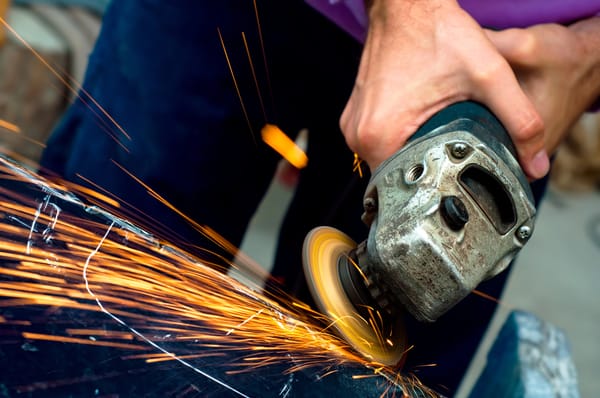An unguarded moment costs company $75,000
By Jeff Salton
Four items feature regularly in workplace health and safety accidents – forklifts, ladders, quad bikes and angle grinders.
Today, we feature a serious accident cause by an unguarded angle grinder. Mr Steven Zappia, an employee of Carroll Springs Pty Ltd (Carroll Springs), was using an unguarded angle grinder with an oversize disc when he was struck on the left shoulder and face by the cutting disc, causing an 8cm long gash on his face and a fractured cheekbone.
When the accident occurred, in May 2015, Mr Zappia was beneath a Toyota Landcruiser removing metal brackets with the angle grinder in order to fit a new suspension spring kit.
He was sitting down on the ground with his arms outstretched at approximately head height. He was wearing safety glasses and was holding the angle grinder approximately 40 cm in front of his face when the angle grinder either kicked back or the disc shattered.
The impact caused a deep laceration (in some areas down to the bone) on the left side of Mr Zappia’s face and a fractured cheekbone. The cut ran from the corner of Mr Zappia’s eye to the bottom of his cheek.He was taken by ambulance to hospital, where he underwent surgery on his facial wound.
Mr Zappia returned to work approximately four weeks later on a graduated work plan. He resigned from the company later that year.
The angle grinder
The angle grinder was meant to be fitted with a cutting disc no larger than 125mm diameter, but was fitted with a 150mm disc, which was rated for a slower speed (10,200rpm max). The grinder had a safety label on it stating to use accessories rated at least 12,000 min/RPM.)
The larger disc could be fitted because the grinder’s guard had been removed by a former employee, before Mr Zappia had begun working for Carroll Springs.
Mr Zappia testified that he did not know where the guard was located. He also said there were no 125mm discs for the angle grinder in the workshop at the time of the incident and that the 150mm disc that was on the angle grinder was the only option available for that grinder, although the workshop manager contested this statement.At the time of the incident Carroll Springs had not developed and implemented a safe system of work for the use of angle grinders or how to select the correct grinding or cuttings discs for angle grinders. Also, manufacturer’s instructions for the angle grinder were located in a drawer in the supervisor’s office at the premises and were not readily accessible to workers.
Prior to the incident the company conducted general inspections of the workplace every two to three months to identify safety hazards but did not include an individual inspection of each power tool. At the time of an inspection of 31 March 2015, the angle grinder was kept in a locked cupboard away from where the tools were normally kept and therefore was not inspected.
Lack of safety management
The company’s lack of a safety management system was criticised by the judge, including:
- Mr Zappia had not been instructed to use an appropriate disc when using the angle grinder;
- there was no risk assessments that identified using an angle grinder without a guard as being a risk;
- there was no risk assessment that identified using an inappropriately rated disc as being a risk;
- the appropriate cutting discs and the guard were available on the site, but in a locked cabinet. Employees should have been made aware they were accessible;
- the existence of the risk was known or should have been known;
- the risk of this accident happening was obvious;
- simple remedial steps were available which would have completely avoided the risk; and
- the risk was one of serious injury or death.
Judge Russell said this was not a case where there was a momentary lapse in ensuring that safe working methods were followed. “Until this event, there was no adequate system of work requiring use of a guard and an appropriately rated disc in the angle grinder.”
He found the offender’s level of culpability was in the upper end of the low range.
The company’s owner expressed deep regret and remorse that the incident occurred and cooperated fully with SafeWork and continued to have an involvement with SafeWork through the Mentor Program and the Leadership Forum.
Carroll Sprints, having a previous good health and safety record, was convicted and fined $100,000 (reduced to $75,000 for an early guilty plea) and was ordered to pay the prosecutors’ costs. The maximum penalty for the offence is a fine of $1.5 million.
From the experts behind the Health & Safety Handbook, the Bulletin brings you the latest work health and safety news, legal updates, case law and practical advice straight to your inbox every week.

